The analysis of acupoint selection rules for acupuncture treating functional constipation
Ai-Li Xu, Xing-Hua Xiang , Hai-Xia Shi, Deng-Ke Liu, Ning-Juan Yan, Yi-Qing Zhang, Wei Yang Wei Wei✉
1.Department of Gastroenterology, Wangjing Hospital, China Academy of Chinese Medical Sciences Beijing 100102
2.Institute of Basic Research in Clinical Medicine, China Academy of Chinese Medical Sciences Beijing 100700
3.Hunan University of Science and Technology Hunan Xiangtan 411201
Keywords:
ABSTRACT
1. Introduction
Functional constipation(FC) is one of the common functional gastrointestinal diseases, with a prevalence of 6% in the Chinese population, which clinical manifestations are persistent difficulty in defecation, decreased stool frequency, or a sense of incomplete defecation [1-2]. In the treatment, acupuncture is widely used in the clinical application of FC. In recent years, more and more clinical trials have focused on the actual role of acupuncture in treating FC. The choice of different acupoints and the compatibility of acupoints directly affect the therapeutic effect [3-5]. Therefore, this study mainly included the randomized controlled trials of acupuncture treatment for FC, which were published in the past ten years. It mainly analyzes the prescription rules of acupuncture points and deeply explores the compatibility of formula and core recipes, in order to provide scientific basis for acupuncture clinical and scientific research.
2. Materials and Methods
2.1 Source of Data
The combination of "Acupuncture", "functional constipation" and "random" was used as the subject words to retrieve the randomized controlled trials of acupuncture treatment for FC, which were published in PubMed, CNKI, Wanfang and Vip databases from January 31, 2010 to January 31, 2020, in order to establish database as the analysis data.
2.2 Inclusion Criteria
(1) Study Types: Clinical researches, the randomized controlled trials of acupuncture treatment for FC; (2) Research subjects: meet the diagnostic criteria of FC, and the patients are not limited in age, gender, and course of disease; (3) acupoint information has been provided in detail during acupuncture intervention; (4) at least one of the evaluation indicators reflects acupuncture as the main clinical Recognized indicators of curative effect, such as the evaluation of the main clinical symptoms, intestinal motility and anorectal function evaluation, quality of life evaluation, and evaluation of the efficacy of traditional Chinese medicine syndromes in the Consensus on Integrated Diagnosis of Traditional Chinese and Western Medicine in Functional Constipation[1]; (5) When multiple analyses of the same research are published into multiple papers, only one study is counted.
2.3 Exclusion Criteria
(1) Non-clinical randomized controlled trials; (2) Not limited to patients with chronic constipation in FC; (3) Clinical evaluation indicators are not recognized, such as self-designed efficacy judgment indicators.
2.4 Research Methods
2.4.1 Screen Literature
Literature search and screening were independently performed by two researchers, and the screened literatures were compared one by one. If there is any inconsistency, the literatures will be finally included in the discussion.
2.4.2 Establish Database
Using Microsoft Office Excel 2007 professional software to mark every study with the full name of the first author and the year of publication, and the acupoints information as well as meridians in all randomized controlled trials that met the inclusion or exclusion criteria were entered, establishing a database.
2.4.3 Data Analysis
Professional statisticians use R3.6.2 software and apply descriptive statistical methods to analyze the frequency of use of single acupoint and the frequency of belonging to meridians. Association rules were used to explore the combination of different acupoints. The minimum support is set to 0.1 and the minimum confidence is 0.5. The association rule diagram is used to express the compatibility relationship of acupoint prescriptions. The arrow shows the direction of the relationship. The circle in the middle indicates the confidence level of this rule. The larger the circle, the greater the confidence. The depth of the circle color indicates the strength of the support. The deeper the circle color, the greater the rule support.
3. Results
Based on the preset inclusion or exclusion criteria, 26 randomized controlled trials were finally incorporated, including 3 clinical trials published in English, in which 2 were published by Chinese scholars [6-7], and 1 by Korean scholars [8]. Another 23 clinical trials were published in Chinese [9-31], from 2010 to 2019. In the analysis, the acupoints information with the best curative effect in randomized controlled trials were counted. The specific results are as follows.
3.1 Frequency Analysis of Selected Acupoints
A total of 26 acupoint prescriptions were included in this study, with a total of 29 acupoints. The acupoints of acupuncture treatment for FC ranked frequently in the top 10 are shown in Table 1. The top 3 frequency of used acupoints were Tianshu (ST25, 23 times, 88.46%), Shangjuxu (ST37, 15 times, 57.69%), and Zhongwan (CV12, 9 times, 34.62%).
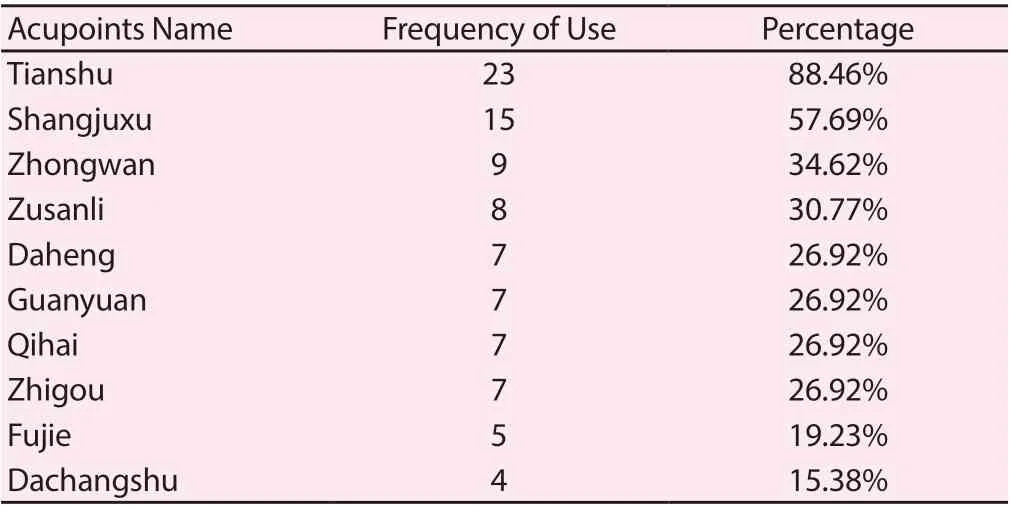
Table 1 Frequency Analysis of Selected Acupoints of Acupuncture for Functional Constipation
3.2 Frequency Analysis of Selected Meridians and Acupoints
Based on the analysis of the meridians of the acupoints, a total of 10 meridians were involved, and the total frequency of all acupoints is 116. Table 2 shows the frequency of the selected acupoints and meridians of acupuncture for FC. The top 3 most frequently used meridians are Stomach Meridian of Foot-Yangming(47 times, 40.52%), Ren Meridian(20 times, 17.24%), and Spleen Meridian of Foot-Taiyin(20 times, 17.24%).
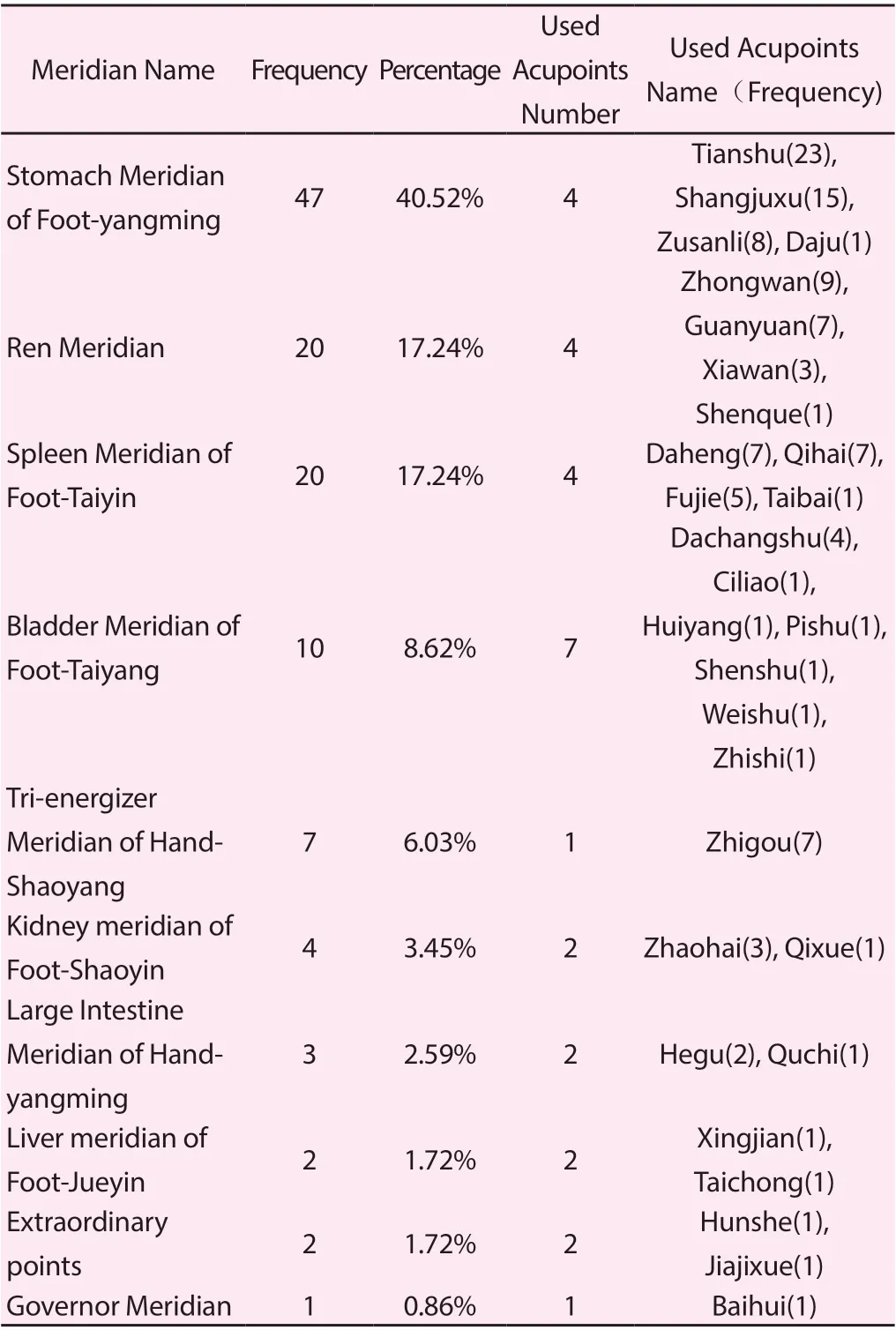
Table 2 Frequency Analysis of Meridians and Acupoints of Acupuncture Treatment for Functional Constipation
3.3 Rule Analysis of Combination of Acupoints
The association analysis method was used to mine the compatibility rules of two acupoints for acupuncture treatment of FC. The support degree of the compatibility acupoints that is greater than 0.2 are showed in table 3. Among them, the two compatible acupoints with high support degree and the top three compatibility frequencies are Tianshu and Shangjuxu, Tianshu and Zhongwan, Tianshu and Zusanli. Mining the compatibility rules of three acupoints for acupuncture treatment of FC. The support degree of the compatibility acupoints that is greater than 0.15 are presented in table 4, of which the three compatible acupoints with high support degree and the top two compatibility frequencies are Tianshu, Shangjuxu and Zusanli, as well as Tianshu, Shangjuxu and Zhigou.
Data mining was performed on the top 10 acupoints compatible with each other to draw the diagram of association rules, as shown in Figure 1. Based on the analysis of confidence and support degree, Tianshu and Shangjuxu are the core acupuncture prescriptions for the treatment of FC.
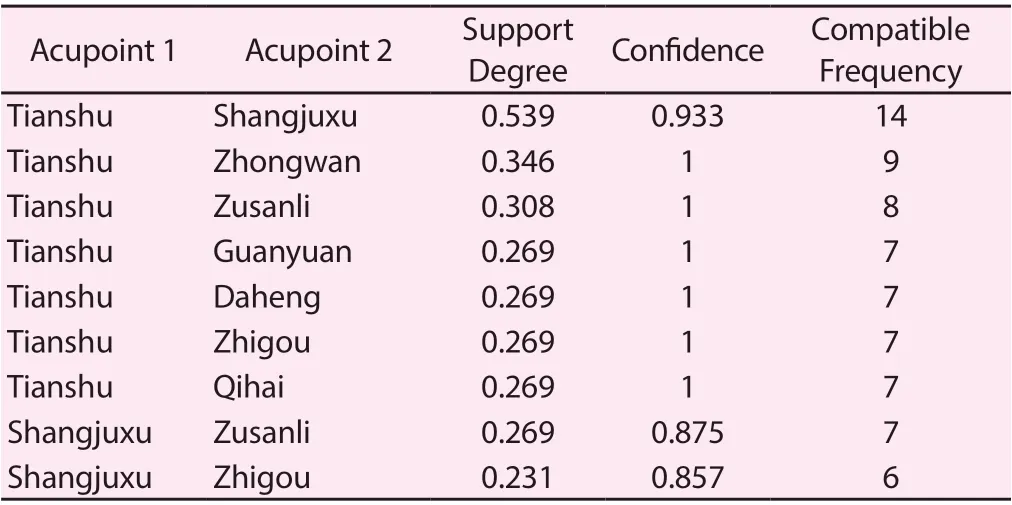
Table 3 Compatibility Analysis of Two Points for Acupuncture Treatment of Functional Constipation

Table 4 Compatibility Analysis of Three Points for Acupuncture Treatment of Functional Constipation
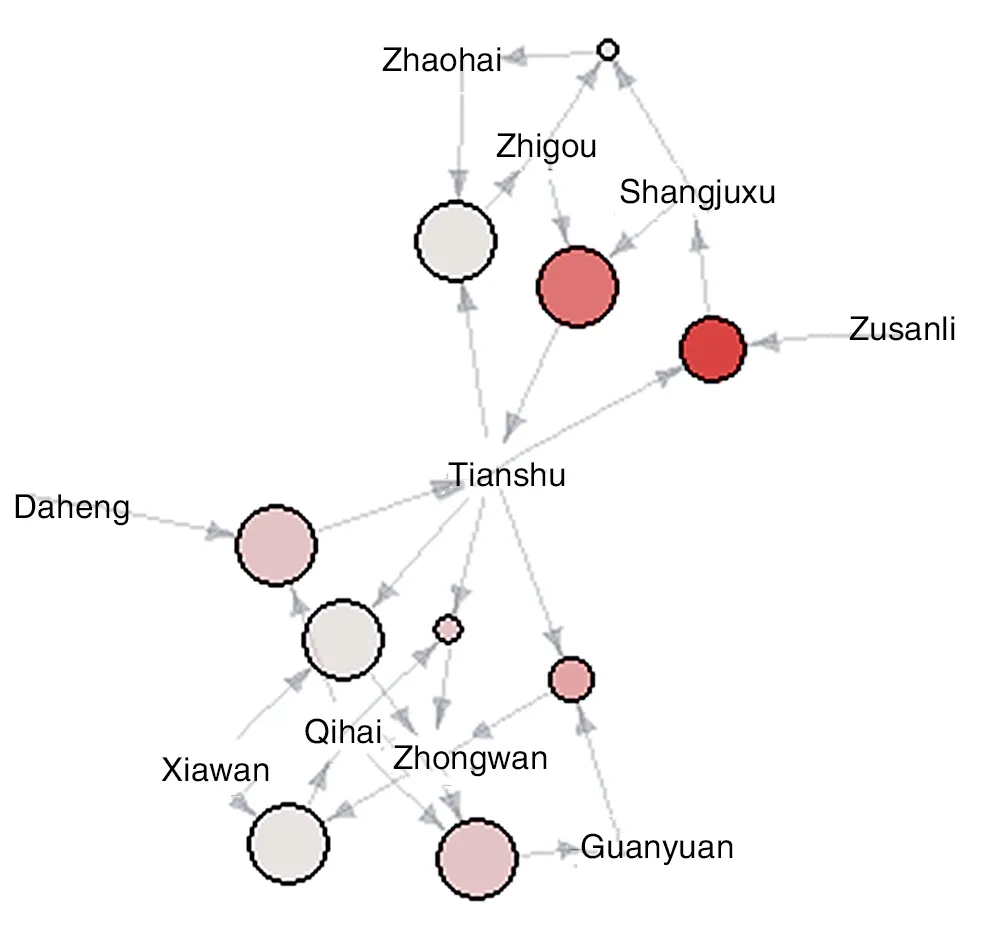
4. Discussion
In recent years, the incidence of FC has been increasing with aging, which not only seriously affects the living quality of patients, but also can cause many diseases such as cardiovascular and cerebrovascular diseases, so the treatment for FC is of great significance [32-33]. Although randomized controlled trials of acupuncture treatment of FC have gradually increased and standardized in the past ten years, few studies have analyzed and summarized the application rules of acupoints, thus lacking general guidance for clinical practices and scientific researches.
Based on the key issue, this study carried out data mining making use of the existing randomized controlled trials, aiming at exploring the acupoints application rules and core acupoint prescriptions in the acupuncture treatment of FC. Among the 26 clinical trials included, Tianshu acupoint appeared up to 23 times, which was used in almost all studies and gained widespread consensus among acupuncturists. However, Tianshu is the front Mu point of the large intestine, issued by Yangming pulse, and mainly makes Intestines smooth and harmonize,as well as regulating qi-flowing for activating stagnancy, which has a very important effect on the treatment of FC. Reticulated meta-analysis of chronic constipation also indicates that the most commonly used acupoint for acupuncture is Tianshu [34]. From the meridian analysis of acupoints, the frequency of Zuyangming Stomach Meridian was the highest, and Tianshu, Shangjuxu, and Zusanli were more frequently used. The Shangjuxu is the lower confluent acupoint of the large intestine. The "Huang Di Nei Jing Su Wen" states that "lower confluent acupoints heal the internal organs", and it has been applied 15 times in the acupoints for treating the disease, second only to Tianshu acupoint. Therefore, in the treatments of functional bowel diseases, Shangjuxu has been widely used in clinical and basic researches [35-36]. The second is Ren meridian called the "Sea of Yin Meridians", of which the most commonly used are Zhongwan and Guanyuan. Zhongwan is the front Mu acupoint of Stomach Meridian and the influential point of Fu-organ of the eight influential points. Guanyuan is the front Fu point of Small Intestine Meridian and the confluent acupoint of three Yin Meridians of Foot as well as Ren Meridian. The third is the Spleen Meridian of Foot-Taiyin. Daheng and Qihai points are more commonly used. The analysis of the compatibility of the two points and the three points manifests that the support degree and compatibility frequency of Tianshu and Shangjuxu are the highest. The two belong to the compatibility of He-Sea acupoint and front Fu acupoint, which is mainly used to treat Fu-organ disease, and is an important form of matching acupuncture points. Dong concluded that the compatibility of He-Sea acupoint and front Fu acupoint is often used in the treatments of spleen and stomach diseases. The Lower He-Sea acupoints are mainly used in the internal Fu-organs, focusing on descending,while the Front-mu acupoints focus on the evils of Fu-organs or Yang meridians, and the two work together to enhance the efficacy [37]. Tianshu and Zhongwan, Tianshu and Zusanli also have higher confidence and compatibility frequencies, and are commonly used in the treatments of gastrointestinal diseases as well. Cheng analyzed the literature based on the basic prescriptions of Zhongwan, Tianshu, and Shangjuxu, and found that the acupoints compatibilities are highly used in intestinal diseases, and have good clinical effects and clinical value [38]. In this study, Tianshu, Shangjuxu and Zusanli, as well as Tianshu, Shangjuxu and Zhigou have relatively high support degree and compatibility frequency in the analysis of the compatibility of the three acupoints, further confirming that Tianshu and Shangjuxu are the core acupoints of acupuncture treatments for FC.
At the same time, a randomized controlled trial published in the American Annals of Internal Medicine in 2016 was included in this study. Tianshu, Shangjuxu and Fujie were used to treat chronic severe FC. Compared with shallow electroacupuncture, the results showed that electroacupuncture could effectively and safely increase the numbers of complete defecation of patients after 8 weeks of treatment, and the curative effects can last 12 weeks [7]. Based on the results of data mining, whether it is a combination of two or three acupoints, the compatibility of Tianshu and Shangjuxu has a relatively high degree of confidence and support, which is consistent with acupoints compatibilities of high-quality randomized controlled trials. According to research results, it is suggested that Tianshu and Shangjuxu can be used as the core acupoint prescription or basic acupoint prescription for the treatments of FC to carry out clinical practices and scientific researches, so as to ensure a certain evidencebased basis. On this basis, exploring the best acupoint compatibility or dialectically applying acupuncture points, clinical practices will be more targeted, thereby improving clinical efficacy and research value.
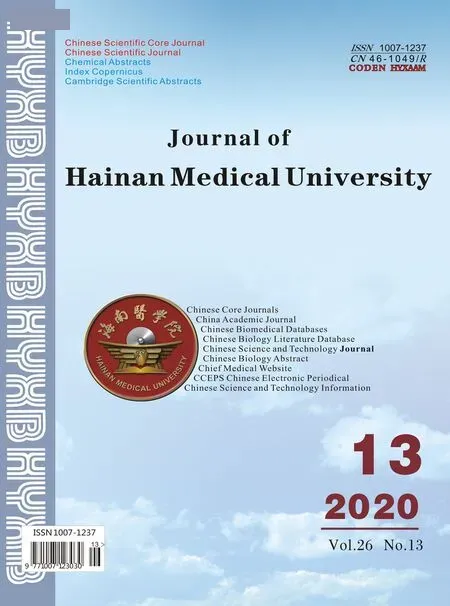 Journal of Hainan Medical College2020年13期
Journal of Hainan Medical College2020年13期
- Journal of Hainan Medical College的其它文章
- Effects of lumbar sagittal balance remodeling on natural absorption after lumbar disc herniation
- Network pharmacology of threatened abortion treated by ShouTaiWan
- Characteristic changes of intestinal flora and its correlation with clinical indexes in patients with Behcet's disease based on TCM syndromes
- Meta analysis of clinical efficacy of combination of traditional Chinese and western medicine in the treatment of venous ulcer of lower extremities
- Effect of high flux hemodialysis on renal anemia and soluble transferrin receptor in hemodialysis patients
- The correlation between different ABO blood group gene loci and the pathogenesis and prognosis of acute myocardial infarction
